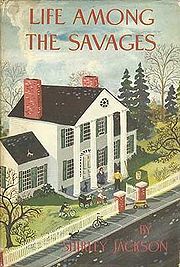
Life Among the Savages
Encyclopedia

Short story
A short story is a work of fiction that is usually written in prose, often in narrative format. This format tends to be more pointed than longer works of fiction, such as novellas and novels. Short story definitions based on length differ somewhat, even among professional writers, in part because...
edited into novel form, written by author Shirley Jackson
Shirley Jackson
Shirley Jackson was an American author. A popular writer in her time, her work has received increasing attention from literary critics in recent years...
. Originally these stories were published individually in women's magazines such as Good Housekeeping
Good Housekeeping
Good Housekeeping is a women's magazine owned by the Hearst Corporation, featuring articles about women's interests, product testing by The Good Housekeeping Institute, recipes, diet, health as well as literary articles. It is well known for the "Good Housekeeping Seal," popularly known as the...
, Woman's Day
Woman's Day
Woman's Day is aimed at a female readership, covering such subjects as food, nutrition, fitness, beauty and fashion. The magazine edition is one of the "Seven Sisters", a group of women's service magazines....
, Mademoiselle
Mademoiselle (magazine)
Mademoiselle was an influential women's magazine first published in 1935 by Street and Smith and later acquired by Condé Nast Publications....
, and others. Published in 1952, Life Among the Savages is a moderately fictionalised memoir
Memoir
A memoir , is a literary genre, forming a subclass of autobiography – although the terms 'memoir' and 'autobiography' are almost interchangeable. Memoir is autobiographical writing, but not all autobiographical writing follows the criteria for memoir set out below...
of life with Jackson's own four children, an early work in what Laura Shapiro calls "the literature of domestic chaos".
Plot summary
Jackson — speaking as the nameless mother who serves as narrator — relates a period of roughly six years in the life of her family, focusing particularly on her attempts to keep peace and domestic efficiency despite her increasing number of children. As the book's primary incidents begin the mother has "two children and about five thousand books" and predicts that before they leave their home they will have "twenty children and easily half a million books". The two children are Laurie and Jannie, named for and based largely on Jackson's two eldest children. Laurie is five, just beginning kindergarten, and "clamoring for the right to vote on domestic policies"; Jannie is nearly two. Eventually a third child, Sally — likewise named for and based upon Jackson's own third child — is introduced into the often overwhelming hilarity and chaos of domestic life, as the three children evolve into highly independent personalities. The book closes with the birth of yet another baby, Barry, who is again a fictional stand-in for Jackson's youngest child.Characters
- The Narrator: A stay-at-home mother who is never identified by name, she maintains the role of detached, amused observer. Despite several attempts to hire domestic help, she is invariably the only force that can make her family's gears mesh smoothly. The narrator is assumed to be Shirley Jackson herself.
- The Children's Father: Referred to only as "my husband", the children's father is assumed to be a representation of Jackson's own husband, Stanley Edgar HymanStanley Edgar HymanStanley Edgar Hyman was a literary critic who wrote primarily about critical methods: the distinct strategies critics use in approaching literary texts. Though most likely to be remembered today as the husband of writer Shirley Jackson, he was influential for the development of literary theory in...
(once his initials are given as S.E.H.). Although the children's father can be motivated to involve himself in such manly pursuits as shooting at stray rodents with an air gun and cheering at Laurie's Little LeagueLittle LeagueLittle League Baseball and Softball is a non-profit organization in South Williamsport, Pennsylvania, United States which organizes local youth baseball and softball leagues throughout the U.S...
games, he is mostly a stereotypical hands-off father who makes domestic proclamations from behind his newspaper. He is also shown to be deeply interested — nearly obsessed — with his coin collection.
- Laurie: A good-natured, athletic little boy, Laurie enjoys a variety of typical all-American pursuits including baseball, Cub Scouts, horses, and getting into scuffles. Like any small boy, he resents when his mother shows him too much affection in public, and he frequently expresses embarrassment of his younger sisters (whom he refers to collectively as "the kids"). One of the major points in the story comes when Laurie is struck by a car and injured; although this is played off for comedy in the book, this incident actually occurred with the real Laurence Hyman. He is five when the major action opens and about nine when the story ends.
- Jannie: Jannie is roughly three years younger than Laurie. She is presented as an imaginative yet extremely traditionally feminine little girl who enjoys playing games of make-believe with her dolls and her seven imaginary "daughters". While Jannie often deliberately sets herself up as the winsome "good girl" to Laurie's more frequent naughtiness ("Was Laurie bad? I'm good, aren't I? Did Laurie do something new bad?"), the two older children often work in collusion to frustrate their parents.
- Sally: Referred to for much of the book as "the baby" (until the prospect of another infant usurps her status), Sally is roughly three years younger than Jannie. While occasionally joining forces with her older siblings, Sally is more often described as living in "a form-fitting fairyland". She is highly imaginative, to the point of baffling her parents, and is often stubborn and self-assured beyond her years.
- Barry: The youngest of the children, Barry appears only as a baby newly arrived from the hospital. The other children admire him briefly ("I guess we figured on something a little bigger") before dismissing him as something to keep their mother busy now that they "are all grown up."

